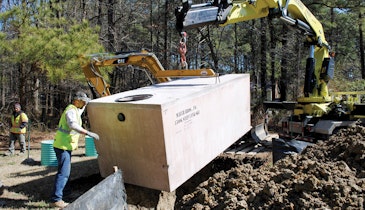Driving through Heritage Lake Estates in Puslinch, Ontario, it’s hard to imagine it previously was home to a steady stream of heavy equipment and dump trucks. Today, well-manicured lawns and homes torn straight from the pages of magazines dot the shoreline and area surrounding a lake that – not that long ago – was a quarry.
Part of this new housing development is the infrastructure build out needed to supply water and power and to treat waste. These components must be designed to meet the demands of future homeowners, as well as the needs of the land, while complying with all applicable codes.
Each home in the development is privately serviced for wastewater treatment. With homes maximizing the 20% allowable building coverage area per lot, each lot’s disposal area is limited. A professional land surveying and engineering company takes the architectural house plans and sites them on the properties to ensure that they comply with the zoning requirements and to determine the drainage characteristics of the soil.
A hydrogeological study for Heritage Lakes set the target effluent nitrate concentration at 14 mg/L. Most systems typically achieve a 30-50% nitrate reduction. In this development, however, the engineering team determined that each system needed to reduce the effluent nitrate concentration by 65%.
The soils in the Heritage Lakes development vary greatly, as well, ranging from native gravel that allows for a small filter bed to much less permeable native soil that requires an area bed or a shallow buried trench bed. As a result, each lot’s dispersal system is unique.
Fortunately, precast concrete treatment systems may be custom engineered to meet all codes, standards and unique site conditions. Each home’s onsite system consists of a series of three precast tanks. To save space on site, the precast concrete manufacturer reduced the tank’s standard footprint by 40%. Being able to produce unique tanks for the job, while providing durable, resilient structures to house the advanced treatment components, were key factors for the job.
Inside the first tank is an advanced treatment system featuring an anaerobic digester with a long tube that runs from the inlet to the outlet back to the inlet. Next, the effluent is transferred to a basket tank, which contains foam cubes that harbor microorganisms. The wastewater is pumped from the digester tank and is sprayed onto the foam cubes. The pump in the basket tank transfers the effluent to the last tank for denitrification and discharges the wastewater to the disposal bed.
By using precast concrete tanks in combination with the advanced treatment system, homeowners can rest easy knowing that their systems meet local requirements, protect soil and groundwater, and stand the test of time thanks to precast concrete’s durability and resilience.
The National Precast Concrete Association has represented manufacturers of industrial plant-produced precast concrete products and the suppliers of products and services for the industry since 1965. It is dedicated to expanding the use of quality precast concrete and providing members with the programs and information required to operate a successful precast plant. NPCA represents 950 member companies in 12 countries, all 50 states and eight Canadian provinces, and provides the industry’s largest and most comprehensive plant certification program.
800-366-7731 | technical@precast.org | www.precast.org/onsite



